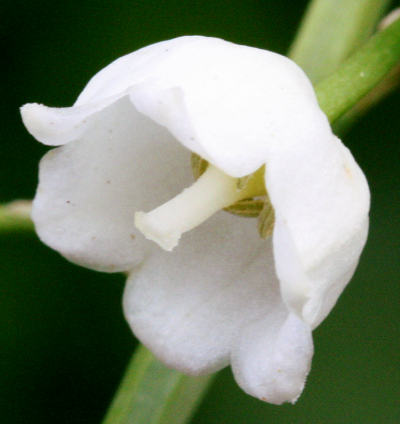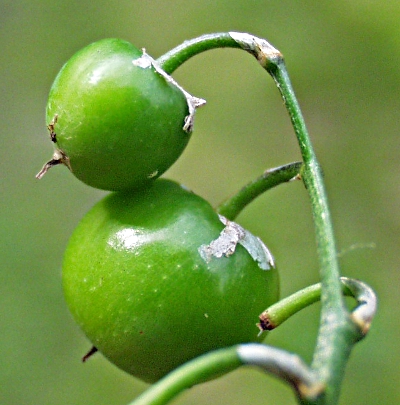Lily of the valley |



Habit, flower and unripe fruits of the lily of the valley
| Convallaria majalis L. | |
| Blooming period: | May–June |
| Height: | 18–30 cm |
| Flowers: | bisexual,
actinomprphic, Ø 5-7 mm, stamens: 6, styles: 1 |
| Tepals: | 6, white, fused, bell-shaped |
| Stem leaves: | missing |
| Basal leaves: | usually 2, stalked, simple, entire, parallel-veined |
Plant perennial, herbaceous, glabrous with a short, branched rootstock and 1–2 creeping underground runners.
Basal leaves 1–4, usually 2, parallel-veined, long-petiolate, simple, entire, parallel-veined, acute or acuminate, elliptical.
Stem leafless (scape), slightly bent, at the base surrounded together with the leaves by a membranous sheath (appearant stalk).
Flowers fragrant, wide bell-shaped, nodding, in terminal, unilateral racemes of 5– 15, stalked, bracts shorter than the pedicel.
Tepals 6, not in divided in corolla and calyx (= perigonium), fused largely, only at the apex free and slightly bent back. The 6 stamens that are fused to the corolla tube and the style are enclosed by the flower.
After selfing or insect pollination are formed round, bright orange red, soft berries with 1–5 seeds. All parts of the plant highly poisonous!
| Floral formula: |
| * [P6 A6] G(3) superior |
Occurrence:
Deciduous
and coniferous forests, forest edges. Prefers shady, not too
nitrogenous locations.
Distribution:
Originally
temperate zones of Europe, Asia and North America. As ornamental plant
spread worldwide.